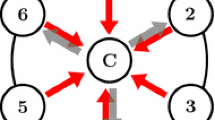Abstract
This paper investigates whether endpoint Cartesian variables or joint variables better describe the planning of human arm movements. For each of the two sets of planning variables, a coordination strategy of linear interpolation is chosen to generate possible trajectories, which are to be compared against experimental trajectories for best match. Joint interpolation generates curved endpoint trajectories calledN-leaved roses. Endpoint Cartesian interpolation generates curved joint trajectories, which however can be qualitatively characterized by joint reversal points.
Though these two sets of planning variables ordinarily lead to distinct predictions under linear interpolation, three situations are pointed out where the two strategies may be confused. One is a straight line through the shoulder, where the joint trajectories are also straight. Another is any trajectory approaching the outer boundary of reach, where the joint rate ratio always appears to be approaching a constant. A third is a generalization to staggered joint interpolation, where endpoint trajectories virtually identical to straight lines can sometimes be produced. In examining two different sets of experiments, it is proposed that staggered joint interpolation is the underlying planning strategy.
Similar content being viewed by others
References
Abend W, Bizzi E, Morasso P (1982) Human arm trajectory formation. Brain 105:331–348
Atkeson CG, Hollerbach JM (1985) Kinematic features of unrestrained vertical arm movements. J Neurosci 5:2318–2330
Bernstein N (1967) The coordination and regulation of movements. Pergamon Press, Oxford
Bishop A, Harrison A (1977) Kots and Syrovegin, (1966) — a demonstration of modular units in motor programming? J Human Movement Stud 3:99–109
Bizzi E, Chapple W, Hogan N (1982) Mechanical properties of muscles: implications for motor control. Trends Neurosci 5 (11):395–398
Bizzi E, Accornero N, Chapple W, Hogan N (1984) Posture control and trajectory formation during arm movement. J Neurosci 4:2738–2745
Brady JM (1982) Trajectory planning. In: Brady JM, Hollerbach JM, Johnson TL, Lozano-Perez T, Mason MT (ed) Robot motion: planning and control. MIT Press Cambridge, MA, pp 221–243
Burlington RS (1942) Handbook of mathematical tables and formulas. Handbook Publ Inc, Sandusky, Ohio
Flash T, Hogan N (1985) The coordination of arm movements: an experimentally confirmed mathematical model J Neurosci 5:1688–1703
Hildreth EC, Hollerbach JM (1986) Artificial Intelligence: a computational approach to vision and motor control. In: Plum F (ed) Handbook of physiology. American Physiological Society (in press)
Hogan N (1984) An organizing principle for a class of voluntary movements. J Neurosci 4:2745–2754
Hollerbach JM (1981) An oscillation theory of handwriting. Biol Cybern 39:139–156
Hollerbach JM (1985) Computers, brains, and the control of movement. In: Evarts EV, Wise SP, Bousfield D (ed) The motor system in neurobiology. Elsevier Biomedical Press, Amsterdam, pp 140–146
Hollerbach JM (1985) Optimum kinematic design for a seven degree of freedom manipulator. In: Hanafusa H, Inoue H (ed) Robotics research: the second international symposium. MIT Press Cambridge, MA, pp 215–222
Hollerbach JM, Atkeson CG (1986) Characterization of joint-interpolated arm movements. In: Heuer H, Fromm C (ed) Generation and modulation of action patterns. Springer New York (in press)
Hollerbach JM, Flash T (1982) Dynamic interactions between limb segments during planar arm movement. Biol Cybern 44:67–77
Kots YM, Syrovegin AV (1966) Fixed set of variants of interaction of the muscles of two joints used in the execution of simple voluntary movements. Biofizika 11:1061–1066
Lacquaniti F, Terzuolo CA, Viviani P (1983) The law relating the kinematic and figural aspects of drawing movements. Acta Psycologica 54:115–130
Morasso P (1981) Spatial control of arm movements. Exp Brain Res 42:223–227
Morasso P, Mussa Ivaldi FA (1982) Trajectory formation and handwriting: a computational model. Biol Cybern 45:131–142
Nashner LM, McCollum G (1985) The organization of human postural movements: a formal basis and experimental synthesis. Behav Brain Sci 8:135–172
Polit A, Bizzi E (1979) Characteristics of motor programs underlying arm movements in monkeys. J Neurophysiol 42:183–194
Sahar G, Hollerbach JM (1986) Planning of minimum-time trajectories for robot arms. Int J Robotics Res 5 (3):90–100
Soechting JF, Lacquaniti F (1981) Invariant characteristics of a pointing movement in man. J Neurosci 1:710–720
Soechting JF, Lacquaniti F, Terzuolo CA (1986) Coordination of arm movements in three-dimensional space. Sensorimotor mapping during drawing movement. Neuroscience 17:295–311
Soechting JF, Ross B (1984) Psychophysical determination of coordinate representation of human arm orientation. Neuroscience 13:595–604
Viviani P, Terzuolo C (1982) Trajectory determines movement dynamics. Neuroscience 7:431–437
Author information
Authors and Affiliations
Rights and permissions
About this article
Cite this article
Hollerbach, J.M., Atkeson, C.G. Deducing planning variables from experimental arm trajectories: Pitfalls and possibilities. Biol. Cybernetics 56, 279–292 (1987). https://doi.org/10.1007/BF00319509
Received:
Issue Date:
DOI: https://doi.org/10.1007/BF00319509



